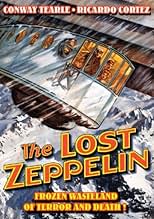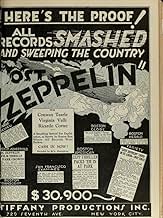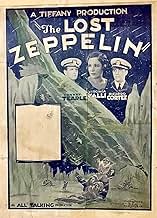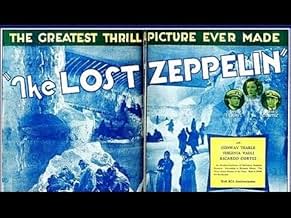VALUTAZIONE IMDb
5,4/10
171
LA TUA VALUTAZIONE
Aggiungi una trama nella tua linguaRight before embarking on his South Pole mission Commander Hall hears his wife's confession that she loves his co-explorer Tom. Hall remains silent, they crash their zeppelin and only one of... Leggi tuttoRight before embarking on his South Pole mission Commander Hall hears his wife's confession that she loves his co-explorer Tom. Hall remains silent, they crash their zeppelin and only one of the two can be picked up by the rescue plane.Right before embarking on his South Pole mission Commander Hall hears his wife's confession that she loves his co-explorer Tom. Hall remains silent, they crash their zeppelin and only one of the two can be picked up by the rescue plane.
- Regia
- Sceneggiatura
- Star
Richard Cramer
- Radio Announcer
- (non citato nei titoli originali)
Ervin Nyiregyhazi
- Pianist
- (non citato nei titoli originali)
William H. O'Brien
- Radio Operator
- (non citato nei titoli originali)
Recensioni in evidenza
First Off, the Scuttlebutt Says that MGM Bought Up All of the Nitrate Prints from the Defunct Studio "Tiffany" to use as "Fuel" for the "Burning of Atlanta" Scene in "Gone With the Wind" (1939).
Hubris and Insensitivity to the "Arts" Aside, if True, it is Amazing that Any Movies from the "Little" Studio are Found Today (they are very rare).
But Here is "The Lost Zeppelin" for your Consideration...It's Quite Awful.
The Groaning Dialog, the Awkward Pauses, the Forced Repeated Narrative. The Film just Slogs From Beginning to End and is a Tough Watch Today.
Squeaky Voiced, Deer in the Headlights, Actress Virginia Valli Made 60 Silent Films and after Attempting a Few Talkies Retired at the Age of 35. She Literally Brings the Movie to a "Crash-Landing" Anytime She's On-Screen.
Ricardo Cortez Fairs Better But Can't Put HIs "Latin Lover" Persona to Much Use, Given the Stale, Stilted, Story of the "Love-Triangle".
The SFX, Sets, Models, and the Rest are Not On Screen Enough to Make an Impression.
The Sappy Dialog and Headline Readings are Recorded OK, but the "Sound Dept" was Over-Thinking the New Technology and Used Over-Modulated, Irritating "Buzzing" for the Crafts and that "Artic-Wind" Howls, and Howls, and Howls.
Most Movies Made at the Time with this Kind of Talent and Resources were Not Much Better. It was a Tough Transition Time Morphing from the "Silents" to "Talkies".
As a Curiosity it is...Worth a Watch
But Be Prepared for some Major "Retro-Shock" Disappointment.
Hubris and Insensitivity to the "Arts" Aside, if True, it is Amazing that Any Movies from the "Little" Studio are Found Today (they are very rare).
But Here is "The Lost Zeppelin" for your Consideration...It's Quite Awful.
The Groaning Dialog, the Awkward Pauses, the Forced Repeated Narrative. The Film just Slogs From Beginning to End and is a Tough Watch Today.
Squeaky Voiced, Deer in the Headlights, Actress Virginia Valli Made 60 Silent Films and after Attempting a Few Talkies Retired at the Age of 35. She Literally Brings the Movie to a "Crash-Landing" Anytime She's On-Screen.
Ricardo Cortez Fairs Better But Can't Put HIs "Latin Lover" Persona to Much Use, Given the Stale, Stilted, Story of the "Love-Triangle".
The SFX, Sets, Models, and the Rest are Not On Screen Enough to Make an Impression.
The Sappy Dialog and Headline Readings are Recorded OK, but the "Sound Dept" was Over-Thinking the New Technology and Used Over-Modulated, Irritating "Buzzing" for the Crafts and that "Artic-Wind" Howls, and Howls, and Howls.
Most Movies Made at the Time with this Kind of Talent and Resources were Not Much Better. It was a Tough Transition Time Morphing from the "Silents" to "Talkies".
As a Curiosity it is...Worth a Watch
But Be Prepared for some Major "Retro-Shock" Disappointment.
Dated adventure film about an attempt to be the first to fly a zeppelin over the South Pole.
The film is essentially two movies. The first is a long drawn out sequence at the start showing how the wife of the head of the expedition is in love with the second in command. This runs for about 25 minutes as they dress go to a send off party and then have guilt over the whole thing. Despite some good dialog this part of the movie is deadly dull. The rest of the film concerns the expedition and is much more interesting. Here we follow the flight as we see the airship fly to toward the Pole and eventually run into trouble (this isn't giving anything away because one need only look at the title to see what happens). This part of the film has some fantastic effects work with the shots of the zeppelin in flight and the Antarctic landscape with all its dangers over powering any feelings that this film is anything less than spectacular. What we see on screen is truly amazing since it was done with out computers and comes across looking oh so more real for it. The films flaws are for the most part limited to the fact that this film was made in the early days of sound and so we either have very talky sequences or ones that are very quiet.
If you want to see some stunning effects in a good adventure you might want to try this, though you'll want to fast forward through the first 25 minutes since they really can be dull. (This would make a good double feature with the Red Tent the true story of similar attempt to fly an airship over the North Pole a few years before this was made, and which was probably the inspiration for this film)
The film is essentially two movies. The first is a long drawn out sequence at the start showing how the wife of the head of the expedition is in love with the second in command. This runs for about 25 minutes as they dress go to a send off party and then have guilt over the whole thing. Despite some good dialog this part of the movie is deadly dull. The rest of the film concerns the expedition and is much more interesting. Here we follow the flight as we see the airship fly to toward the Pole and eventually run into trouble (this isn't giving anything away because one need only look at the title to see what happens). This part of the film has some fantastic effects work with the shots of the zeppelin in flight and the Antarctic landscape with all its dangers over powering any feelings that this film is anything less than spectacular. What we see on screen is truly amazing since it was done with out computers and comes across looking oh so more real for it. The films flaws are for the most part limited to the fact that this film was made in the early days of sound and so we either have very talky sequences or ones that are very quiet.
If you want to see some stunning effects in a good adventure you might want to try this, though you'll want to fast forward through the first 25 minutes since they really can be dull. (This would make a good double feature with the Red Tent the true story of similar attempt to fly an airship over the North Pole a few years before this was made, and which was probably the inspiration for this film)
I struggled to stay with this film to see it to the end. I give it two stars just for a try at a plot. Besides some very good silent films of the 1920s, I've rated about a dozen talkies of 1929 from 7 to 10 stars. Those were all produced by Paramount, MGM, Warner Brothers and a British studio.
"The Lost Zeppelin" was made by one of the 80 or so poverty row studios that existed in the early years of movie making. Tiffany-Stahl lasted longer than most, from 1921 to 1931, and turned out 70 films in that time. This was one of its last. And this film is a good example of why it and the host of poverty row studios didn't last. The few good directors and technicians that started in the lower echelons eventually made it into the big studios or went with a successful independent that would later make it big or merge into one of the other studios.
Normally, I wouldn't bother to review a film I rate so low. But since this is now out on DVD, I thought prospective viewers might like more comment than has been posted on IMDb to this time. I won't urge folks not to watch this – but you should know what to expect before you plunk down cash to buy or rent it. Indeed, I had some inkling of what it was about, but I wanted to see it for myself. And, I'm glad I did – because I now know what the very cheap poverty row films were like.
Everything about this film is poor, with the possible exception of the sound from the dialog. The sets are very amateurish and poor – such as an airplane door that slides open. No kidding – just like a sliding door in a house. Then, when a crew person opens the door, it starts to fall out of its track and he shoves it back. The airplane engine noise is some strange irritating sound created by sound effects, and doesn't sound anything like a plane engine. The film quality itself is barely watchable. The script is something that a third-grade student might create today. But the directing and acting are the very worst.
Conway Tearle and Ricardo Cortez had small movie careers through the 1930s. But those were mostly in B films. The rest of the cast are actors who couldn't make the transition from silent to sound. Virginia Valli had made more than 60 films in the silent era; but after this, she made only two more before retiring from films at age 35. That's when many of the best actors begin to shine. The acting is very hammy in this, and one can see long pauses and long glances at the camera – techniques used in the silent films to allow subtitles to show. While the voices of all this cast were OK, they apparently couldn't transition to real acting. There were many silent film stars who didn't succeed in sound films because their unusual voices didn't fit their images in the minds of the movie-going public.
So, this isn't likely to be very entertaining; but if you want to see an example of the hundreds and even thousands of early films that aren't around anymore – and of the type of films put out by the short-lived and over-night cheap studios, then you may enjoy watching "The Lost Zeppelin."
I found this bit of trivia that movie buffs might enjoy. Apparently, MGM bought Tiffany's original film library and used it for fuel in "Gone with the Wind." It went up in flames in the scene of the burning of Atlanta. I doubt if it was very expensive kindling.
"The Lost Zeppelin" was made by one of the 80 or so poverty row studios that existed in the early years of movie making. Tiffany-Stahl lasted longer than most, from 1921 to 1931, and turned out 70 films in that time. This was one of its last. And this film is a good example of why it and the host of poverty row studios didn't last. The few good directors and technicians that started in the lower echelons eventually made it into the big studios or went with a successful independent that would later make it big or merge into one of the other studios.
Normally, I wouldn't bother to review a film I rate so low. But since this is now out on DVD, I thought prospective viewers might like more comment than has been posted on IMDb to this time. I won't urge folks not to watch this – but you should know what to expect before you plunk down cash to buy or rent it. Indeed, I had some inkling of what it was about, but I wanted to see it for myself. And, I'm glad I did – because I now know what the very cheap poverty row films were like.
Everything about this film is poor, with the possible exception of the sound from the dialog. The sets are very amateurish and poor – such as an airplane door that slides open. No kidding – just like a sliding door in a house. Then, when a crew person opens the door, it starts to fall out of its track and he shoves it back. The airplane engine noise is some strange irritating sound created by sound effects, and doesn't sound anything like a plane engine. The film quality itself is barely watchable. The script is something that a third-grade student might create today. But the directing and acting are the very worst.
Conway Tearle and Ricardo Cortez had small movie careers through the 1930s. But those were mostly in B films. The rest of the cast are actors who couldn't make the transition from silent to sound. Virginia Valli had made more than 60 films in the silent era; but after this, she made only two more before retiring from films at age 35. That's when many of the best actors begin to shine. The acting is very hammy in this, and one can see long pauses and long glances at the camera – techniques used in the silent films to allow subtitles to show. While the voices of all this cast were OK, they apparently couldn't transition to real acting. There were many silent film stars who didn't succeed in sound films because their unusual voices didn't fit their images in the minds of the movie-going public.
So, this isn't likely to be very entertaining; but if you want to see an example of the hundreds and even thousands of early films that aren't around anymore – and of the type of films put out by the short-lived and over-night cheap studios, then you may enjoy watching "The Lost Zeppelin."
I found this bit of trivia that movie buffs might enjoy. Apparently, MGM bought Tiffany's original film library and used it for fuel in "Gone with the Wind." It went up in flames in the scene of the burning of Atlanta. I doubt if it was very expensive kindling.
That this exsists at all is probably a minor miracle. Legend has it that David Selznick purchased all of the Tiffany-Stahl studio's negatives to utilize for the burning of Atlanta sequence in Gone With The Wind. Extant prints of films from this studio are rare, indeed. That aside, The Lost Zeppelin shows that the little studio was indeed trying to be up-to-date in marketing all-talking pictures. The dialouge delivery in the first section of the picture, before we get to the meat of the story, hearkens back to The Lights of New York (1928). Pregnant pauses and actors unsure about how to properly deliver dialouge are apparent. When the story gets to the dirigible party and their problems, the pace picks up and there are some pretty neat (for their time) effects. The studio must be praised for putting forth a story that is at once novel and original. This was released at Christmastime 1929 and it seems to have been successful in some quarters. In it's premiere in St.Louis, for example, the ads reported a take of $30,900 for the Christmas weekend. Pocket change today, but we must remember the time in which it was released. Conway Tearle and Virginia Valli are the top-billed players. The opening credits proclaim that this was "Synchronized by RCA Photophone". The print on the Alpha DVD was acceptably clear. In all, a film which will probably appeal to those who enjoy the early talkies. There are plenty of 20s fashions, hairdos and a huge radio in the living room of the heroine. Radio, in fact, is utilized throughout the film as a way to chart the progress of the Zeppelin. The Zeppelin itself is neatly represented by stock footage and the use of some neat miniatures. This is not an expensive film to buy and will be entertaining to those who enjoy film history.
Stiff upper lips abound in Edward Sloman's frigid tale of love and adventure, not only because zeppelin pilots Conway Tearle and Ricardo Cortez are thoroughly decent chaps at heart, but because the talkies were in their infancy and - with the exception of Tearle - everyone seems to have temporarily forgotten how to act in front of a camera. Cortez's character might be making the moves on Tearle's willing wife (Virginia Valli) but at least he feels awfully guilty about it. Dreary stuff that's only set apart from the countless other drawing room dramas flooding cinemas during the early years of sound by its set-bound Arctic scenes.
Lo sapevi?
- QuizThis film, like Dirigibile (1931), is also loosely based on the crash of the airship "Italia", flown by Umberto Nobile, around 5/25/1928, near the North Pole, and the international rescue effort that cost early polar explorer Roald Amundsen his life. The pilot who rescued Nobile also crashed when returning to rescue more survivors and had to be rescued himself.
- BlooperThe news broadcast heard by Miriam Hall and her house guests announces a cable has arrived from the dirigible sent on August 4 at 4:22 p.m. Eastern Standard Time. That date was in the middle of summer and would have been during Daylight Savings Time, which in 1929 began on in April and ended in late September.
I più visti
Accedi per valutare e creare un elenco di titoli salvati per ottenere consigli personalizzati
Dettagli
- Data di uscita
- Paese di origine
- Lingua
- Celebre anche come
- The Lost Zeppelin
- Luoghi delle riprese
- Azienda produttrice
- Vedi altri crediti dell’azienda su IMDbPro
- Tempo di esecuzione1 ora 12 minuti
- Colore
- Proporzioni
- 1.20 : 1
Contribuisci a questa pagina
Suggerisci una modifica o aggiungi i contenuti mancanti

Divario superiore
By what name was Lo zeppelin perduto (1929) officially released in Canada in English?
Rispondi






















